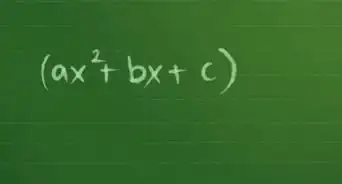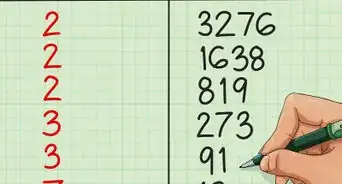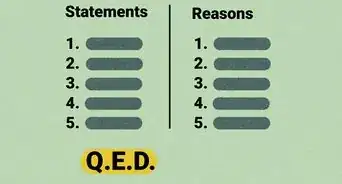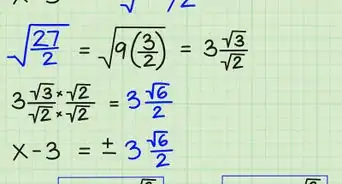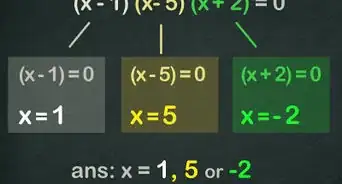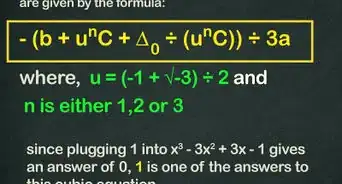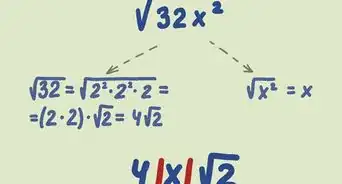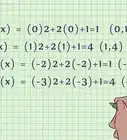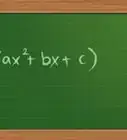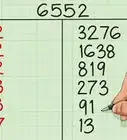wikiHow is a “wiki,” similar to Wikipedia, which means that many of our articles are co-written by multiple authors. To create this article, 61 people, some anonymous, worked to edit and improve it over time.
There are 11 references cited in this article, which can be found at the bottom of the page.
This article has been viewed 663,645 times.
Learn more...
A polynomial contains a variable (x) raised to a power, known as a degree,[1] and several terms and/or constants. To factor a polynomial means to break the expression down into smaller expressions that are multiplied together. These skills are Algebra I and above, and may be difficult to understand if your math skills are not at this level.
Steps
Starting Out
-
1Set up your expression. The standard format for the quadratic equation is:[2]
ax2 + bx + c = 0
Start by ordering the terms in your equation from highest to lowest power, just like this standard format. For example, take:6 + 6x2 + 13x = 0
We will re-order this expression so it's easier to work with by simply moving the terms around:6x2 + 13x + 6 = 0 -
2Find the factored form using one of the methods below. Factoring the polynomial will result in two smaller expressions which can be multiplied to produce the original polynomial:[3]
6x2 + 13x + 6 = (2x + 3)(3x + 2)
In this example, (2x +3) and (3x + 2) are factors of the original expression, 6x2 + 13x + 6.Advertisement -
3Check your work! Multiply the factors you identified. Then combine like terms and you're done. Start with:[4]
(2x + 3)(3x + 2)
Let's test it, multiplying the terms using FOIL (first - outer - inner - last), obtaining:[5]6x2 + 4x + 9x + 6
From here, we can add 4x and 9x together since they're like terms. We know our factors are correct because we get the equation we started with:6x2 + 13x + 6
Trial and Error
If you have a fairly simple polynomial, you might be able to figure out the factors yourself just from sight. For instance, after practice, many mathematicians are able to know that the expression 4x2 + 4x + 1 has the factors (2x + 1) and (2x + 1) just from having seen it so much. (This will obviously not be as easy with more complicated polynomials.) For this example, let's use a less common expression:
-
1List the factors of the a term and the c term. Using the expression format ax2 + bx + c = 0, identify the a and c terms and list out what factors they have. For 3x2 + 2x - 8, that means:
a = 3 and has one set of factors: 1 * 3 c = -8 and has four sets of factors: -2 * 4, -4 * 2, -8 * 1, and -1 * 8. -
2Write down two sets of parentheses with empty spaces. You'll be filling in the constants for each expression into the space you've made:
( x )( x ) -
3Fill the spaces in front of the x's with a pair of possible factors of the a value. For the a term in our example, 3x2, there is only one possibility for our example:
(3x )(1x ) -
4Fill in the two spaces after the x's with a pair of factors for the constants. Let's say we chose 8 and 1. Write it in:
(3x 8)(x 1) -
5Decide what signs (plus or minus) should be between the x variables and the numbers. Depending on the signs in the original expression, it's possible to figure out what the signs for the constants should be. Let's call the two constants for our two factors h and k:
If ax2 + bx + c then (x + h)(x + k) If ax2 - bx - c or ax2 + bx - c then (x - h)(x + k) If ax2 - bx + c then (x - h)(x - k)
For our example, 3x2 + 2x - 8, the signs must be:(x - h)(x + k), giving us the two factors:(3x + 8) and (x - 1) -
6Test your choice using first-outer-inner-last (FOIL) multiplication. A quick first test to run is to see if the middle term is at least the correct value. If it is not, you may have chosen the wrong c factors. Let's test our answer:
(3x + 8)(x - 1)
By multiplication, we arrive at:3x2 - 3x + 8x - 8
Simplifying this expression by adding the like terms (-3x) and (8x), we get:3x2 - 3x + 8x - 8 = 3x2 + 5x - 8
We know now that we must have identified the wrong factors:3x2 + 5x - 8 ≠ 3x2 + 2x - 8 -
7Swap out your choices if necessary. In our example, let's try 2 and 4 instead of 1 and 8:
(3x + 2)(x - 4)
Now our c term is a -8, but our outside/inside product (3x * -4) and (2 * x) is -12x and 2x, which will not combine to make the correct b term of +2x.-12x + 2x = 10x 10x ≠ 2x -
8Reverse the order if necessary. Let's try moving the 2 and 4 around:
(3x + 4)(x - 2)
Now, our c term (4 * 2 = 8) is still okay, but the outside/inside products are -6x and 4x. If we combine them:-6x + 4x = 2x 2x ≠ -2x We're pretty close to the 2x we were aiming for, but it's the wrong sign. -
9Double-check your signs if necessary. We're going to stick with the same order, but swap which one has the minus:
(3x - 4)(x + 2)
Now the c term is still okay, and the outside/inside products are now (6x) and (-4x). Since:6x - 4x = 2x 2x = 2x We can now recognize the positive 2x from the original problem. These must be the correct factors.
Decomposition
This method will identify all possible factors of the a and c terms and use them to figure out what the factors should be. If the numbers are very large or other guesswork-type methods seem like they'd take too long, use this method.[6]
Let's use the example:
-
1Multiply the a term by the c term. In this example, a is 6 and c is also 6.
6 * 6 = 36 -
2Get the b term by factoring and testing. We're looking for two numbers that are factors of the a * c product we identified and also add up to the b term (13).
4 * 9 = 36 4 + 9 = 13 -
3Substitute the two numbers you get into your equation as the sum of the b term. Let's use k and h to represent the two numbers we got, 4 and 9:
ax2 + kx + hx + c 6x2 + 4x + 9x + 6 -
4Factor the polynomial by grouping. Organize the equation so that you can factor out the greatest common factor of the first two terms and the last two terms. Both factored groups should be the same. Add the Greatest Common Factors together and enclose them in parentheses next to the factored group; the result will be your two factors:[7]
6x2 + 4x + 9x + 6 2x(3x + 2) + 3(3x + 2) (2x + 3)(3x + 2)
Triple Play
Similar to the decomposition method, the 'triple play' method[8]
examines possible factors of the product of the a and c terms and uses them to figure out what b must be. Consider for this example the equation:
-
1Multiply the a term by the c term. As with the decomposition method, this is going to help us identify candidates for the b term. In this example, a is 8 and c is 2.
8 * 2 = 16 -
2Find two numbers with this number as a product and with a sum equal to the b term. This step is identical to the decomposition method - we're testing and rejecting candidates for the constants. The product of the a and c terms is 16, and the c term is 10:
2 * 8 = 16 8 + 2 = 10 -
3Take these two numbers and test substitute them into the 'triple play' formula. Take our two numbers from the previous step - let's call them h and k - and put them into this expression:
((ax + h)(ax + k))/ a
Here, we'd get:((8x + 8)(8x + 2)) / 8 -
4Look to see which one of the two terms in the numerator is evenly divisible by a. In this example, we're seeing if (8x + 8) or (8x + 2) can be divided by 8. (8x + 8) is divisible by 8, so we'll divide this term by a and leave the other one as is.
(8x + 8) = 8(x + 1)
The term we're saving out of here is what's left after dividing by the a term:(x + 1) -
5Take the greatest common factor (GCF) out of either or both terms, if any. In this example, the second term, has a GCF of 2, since 8x + 2 = 2(4x + 1). Combine this answer with the term you identified in the previous step. These are your equation's factors.
2(x + 1)(4x + 1)
Difference of Two Squares
Some coefficients in polynomials may be identified as a 'squares', or the product of two numbers. Identifying these squares allows you to factor some polynomials much faster.[9]
Consider the equation:
-
1Factor out a greatest common factor if possible. In this case, we can see that 27 and 12 are both divisible by 3, so we'll separate that out:
27x2 - 12 = 3(9x2 - 4) -
2Identify if your equation's coefficients are square numbers. To use this method you should be able to take the square root of the terms evenly. (Notice that we'll have left out the negative signs - since these numbers are squares they may be products of positive or two negative numbers)
9x2 = 3x * 3x and 4 = 2 * 2 -
3Using the square roots you have identified, write out the factors. We'll take the a and c values from our step above - a = 9 and c = 4, then find their square roots - √a = 3 and √c = 2. These are the coefficients for the factor expressions:
27x2 - 12 = 3(9x2 - 4) = 3(3x + 2)(3x - 2)
Quadratic Formula
If all else fails and the equation will not factor evenly use the quadratic formula.[10]
Consider the example:
-
1Plug the corresponding values into the quadratic formula:
x = -b ± √(b2 - 4ac)
---------------------
2a
We obtain the expression:x = -4 ± √(42 - 4•1•1) / 2 -
2Solve for x. You should get two x values. As shown above, we obtain two answers:
x = -2 + √(3) or x = -2 - √(3) -
3Use your value for x to figure out the factors. Plug the x values you obtained into two polynomial expressions as the constants.[11] These will be your factors. If we call our two answers h and k, we're writing two factors like so:
(x - h)(x - k)
In this case, our final answer is:(x - (-2 + √(3))(x - (-2 - √(3)) = (x + 2 - √(3))(x + 2 + √(3))
Using a Calculator
If you are allowed to use one, a graphic calculator makes the factoring process much easier, especially on standardized tests. These instructions are for a TI graphing calculator. We will use the example equation:
-
1Enter your equation into the calculator. You will use the equation solver, also known as the [Y = ] screen.
-
2Graph the equation using your calculator. Once you've entered your equation, press [GRAPH] - you should see a smooth arc representing your equation (and it will be an arc since we are dealing with polynomials).
-
3Locate where the arc intersects the x axis. Since polynomial equations are traditionally written as ax2 + bx + c = 0, these are the two x values that cause the expression to equal zero:
(-1, 0), (2, 0) x = -1, x = 2 - If you cannot identify where your graph crosses the x axis by sight, press [2nd] and then [TRACE]. Press [2] or select "zero". Slide the cursor to the left of an intersect and press [ENTER]. Slide the cursor to the right of an intersect and press [ENTER]. Slide the cursor as close as possible to the intersect and press [ENTER]. The calculator will find the x value. Do this for the other intersect also.
-
4Plug the x values obtained in the previous into two factorial expressions. If we term our two x-values h and k, the expression we will be using is:
(x - h)(x - k) = 0
Thus, our two factors must be:(x - (-1))(x - 2) = (x + 1)(x - 2)
Community Q&A
-
QuestionIs there a difference between ax^2 + bx + c = 0 and ax^2 + bx + c ?
 OrangejewsCommunity AnswerThe first is an equation. It is true for 2 choices of x, and false for all others. The second is an expression. You can evaluate it for any number x and see what number it equals, but you can't say "solve it," since without an = sign, there is nothing to solve.
OrangejewsCommunity AnswerThe first is an equation. It is true for 2 choices of x, and false for all others. The second is an expression. You can evaluate it for any number x and see what number it equals, but you can't say "solve it," since without an = sign, there is nothing to solve. -
QuestionWhat are the steps to find the solution set of x+4+9-x=5?
 Community AnswerFirst, do all the calculations concerning like terms. You'll get (x-x)+(4+9)=5. Calculate, and you'll get 13=5, which is impossible. Assuming through equation is x^2+4+9+x=5, we get x^2+1x+8=0. Since we cannot find its factors by the a&c or triple play method, we use the quadratic equation and get the roots as {-1+(1-32)^0.5} and {-1-(1-32)^0.5}. Simplified, [{(-31)^0.5}-1] and [{(-31)^0.5}-1]. Not real numbers.
Community AnswerFirst, do all the calculations concerning like terms. You'll get (x-x)+(4+9)=5. Calculate, and you'll get 13=5, which is impossible. Assuming through equation is x^2+4+9+x=5, we get x^2+1x+8=0. Since we cannot find its factors by the a&c or triple play method, we use the quadratic equation and get the roots as {-1+(1-32)^0.5} and {-1-(1-32)^0.5}. Simplified, [{(-31)^0.5}-1] and [{(-31)^0.5}-1]. Not real numbers. -
QuestionWhich is the fastest method to find the value of x, when x^2 - 11x - 87 = 0?
 DonaganTop AnswererUse the quadratic formula (Method 5 above).
DonaganTop AnswererUse the quadratic formula (Method 5 above).
Warnings
- If you are learning this concept in a math class, pay attention to what your teacher advises and do not just use your favorite method. Your teacher may ask you to use a specific method on the test or not allow graphing calculators.⧼thumbs_response⧽
Things You'll Need
- Pencil
- Paper
- Quadratic equation (also called a 2nd degree polynomial)
- Graphing calculator (optional)
References
- ↑ https://www.purplemath.com/modules/polydefs.htm
- ↑ https://www.mathsisfun.com/algebra/quadratic-equation.html
- ↑ http://tutorial.math.lamar.edu/Classes/Alg/Factoring.aspx
- ↑ https://www.khanacademy.org/math/algebra2/x2ec2f6f830c9fb89:poly-factor/x2ec2f6f830c9fb89:factor-high-deg/v/factor-high-deg-poly
- ↑ https://www.mathsisfun.com/definitions/foil-method.html
- ↑ https://www.youtube.com/watch?v=ADmAVu0kZ8U
- ↑ https://www.khanacademy.org/math/algebra/polynomial-factorization/factoring-quadratics-2/a/factoring-by-grouping
- ↑ https://www.youtube.com/watch?v=8wNlXiPlefw
- ↑ http://www.softschools.com/math/algebra/topics/factoring_polynomials_the_difference_of_two_squares/
About This Article
To factor second degree polynomials, set up the expression in the standard format for the quadratic equation, which is ax² + bx + c = 0. Multiply the a term by the c term, then find 2 numbers that multiply to equal the product of a and c, while also adding up to be the b term. Once you have those numbers, substitute them into the equation as the sum of the b term. Factor the polynomial by grouping. Keep reading to learn how to factor second degree polynomials through trial and error!
-Step-1-Version-3.webp)
-Step-2-Version-3.webp)
-Step-3-Version-3.webp)
-Step-4-Version-3.webp)
-Step-5-Version-3.webp)
-Step-6-Version-3.webp)
-Step-7-Version-3.webp)
-Step-8-Version-3.webp)
-Step-9-Version-3.webp)
-Step-10-Version-3.webp)
-Step-11-Version-3.webp)
-Step-12-Version-3.webp)
-Step-13-Version-3.webp)
-Step-14-Version-3.webp)
-Step-15-Version-3.webp)
-Step-16-Version-3.webp)
-Step-17-Version-3.webp)
-Step-18-Version-3.webp)
-Step-19-Version-3.webp)
-Step-20-Version-3.webp)
-Step-21-Version-3.webp)
-Step-22-Version-3.webp)
-Step-23-Version-3.webp)
-Step-24-Version-3.webp)
-Step-25-Version-3.webp)
-Step-26-Version-3.webp)
-Step-27-Version-3.webp)
-Step-28-Version-2.webp)
-Step-29-Version-2.webp)
-Step-30-Version-2.webp)
-Step-31-Version-2.webp)

